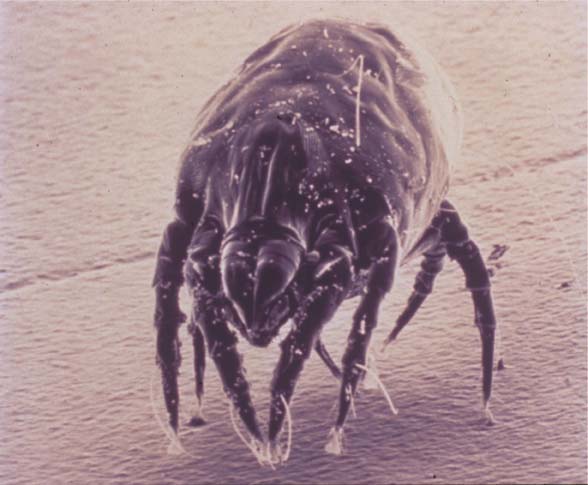March 28, 2005
Does Mite Make Right? Living With Dust Mites
By Michael D. Shaw
Continuing in our series on indoor air pollutants, that has already included living organisms (toxic mold), we now enter the animal kingdom. Say hello to Dermatophagoides farinae and Dermatophagoides pteronyssinus, more commonly known–respectively–as the North American and European House Dust Mite. Not insects, these creatures are part of the Arachnids, that class of arthropods also containing spiders, ticks, and scorpions.
It was Anton van Leeuwenhoek, inventor of the microscope, who reported in 1694 that mites live in dust. These tiny monsters–too small to be seen with the naked eye–reside in the dust all right, and live on shed human skin, fingernails, hair, animal dander, bacteria, fungi, and pollen. While these are their most favored delicacies, crumbs of human and pet foods will also sustain them. Implicated in causing allergy misery (asthma, hay fever, and eczema, among others) in millions of people, it is not the mites themselves, but rather the proteins they produce that are allergenic. The worst of these is the so-called Der p1, helpfully identified in the scientific literature as “house dust mite allergen.” Der p1 occurs in the mite’s fecal pellets and disintegrating body parts.
For the record, household dust itself is composed primarily of human skin and hair, waxes, pollen, fungi, lichen, tiny particles of wood, paint, fibers from fabrics, foam rubber, wallboard, plant and vegetable matter, insect parts, food waste, paper fiber, and metal particles. This lovely mixture is also jazzed up with any number of ambient chemical pollutants that collect on the mass.
While dust mites cannot survive on vinyl or hardwood floors, they surely thrive everywhere that dust accumulates, and do especially well in bedrooms. Mites just love pillows, mattresses, bed springs, blankets, and comforters. Ten percent of the weight of a two-year-old pillow can be composed of dead mites and their fecal pellets. Pleasant dreams!
Here are some numbers that might make you squirm: A typical used mattress can have 100,000 to 10 million mites inside, feeding on the 6 grams of dead skin you shed each week. Each mite produces 10-20 waste pellets per day, and each egg-laying female can produce 25-30 more mites every three weeks. Cold comfort that a mite only lives about three months, especially when its dead carcass is allergenic!
Although it is easy enough to determine if dust mites are at large in your home, via testing under a microscope, most often requests for detection occur after an affected individual is already determined to be suffering from an allergy to the mites. At this point, several remedial actions can be taken.
Fortunately, the little devils require about a 70 percent humidity, and temperatures between 75-80 degrees, so keeping your house below these levels is a good first step. Authorities advise against the use of HEPA (high efficiency purifying air) filters on air conditioner or heater vents. The mites cannot survive on dust in the ducts, and as air emerges from these filters at the resultant higher velocity caused by the small passages, it could stir up more dust, and spread the mites more than would otherwise occur.
For those who are most sensitive to Der p1, the ideal mite-deterrent residence would have no carpet, and no fabric on the windows or furniture. More than that, anything that could collect dust–books, wall hangings, and knick-knacks–would be removed, as well.
All mattresses, carpets, sofas, and chairs should be vacuumed thoroughly. For best results, use a vacuum cleaner provided with a HEPA filtration system, and throw away the bags, since the mites can escape. Wash all bedding materials (pillow cases, sheets, blankets, mattress pads) at least every two weeks in hot water. Fitted sheets also help prevent the accumulation of shed skin. A further step would be encasing mattresses in plastic. Still, complete elimination of these pests is virtually impossible, since control of the environment on a macro level does not eliminate many micro-environments perfect for the mighty mite.
Some authorities stress reducing humidity over sanitation, and various insecticides and fungicides have been shown to be effective. Beware, though, of possible side effects of some of the toxins used in these products. Immunotherapy, whereby mite extracts are injected into the allergy sufferer, to increase the antibody level, has had some success.
It is noted that the typical home has plenty of shed skin flakes floating around in the air. Indeed, fully 80 percent of the material seen floating in a sunbeam is comprised of these particles. While it is true that ozone, generated via certain air purifiers, will attach to such material, the overall beneficial effect of such action is dubious. After all, the mites are already burrowed deep into areas where the shed skin first accumulates. Airborne skin particles are a secondary consideration, at best.
Dust mites, like rats, enjoy the benefits of living around humans, even if they usually overstay their welcome. Until a Pied Piper for dust mites comes along, keeping them under control is the best we can do.

